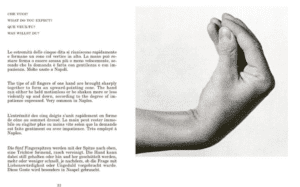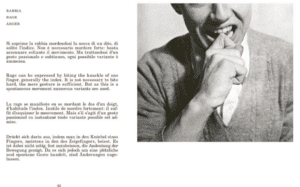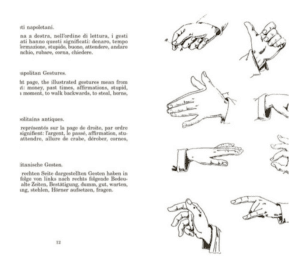Italian hands language is the initial mental images typically of Italy including also pizza, pasta, a rich tapestry of art and culture, and, of course, the expressive manner in which Italians communicate. It’s impossible to discuss the Italian language without acknowledging the intertwined culture of hand gestures that accompanies it.
Italian hands language : The Italian peninsula can be likened to an open-air theater, where individuals employ dramatic hand movements to convey and emphasize their perspectives. The more intricate and passionate a conversation becomes, the more people tend to gesticulate in an increasingly animated fashion.



Sometimes, foreigners, in jest or to poke fun at the Italian hands language for excessive gestures, may begin waving their hands without truly comprehending the precise movements and meanings behind each gesture. What they might not realize is that each gesture possesses a specific movement and meaning, and it should be employed in the appropriate context.
The art of Italian hands language is a universal practice, transcending social classes. Even politicians incorporate hand gestures into their speeches, though at times not with the utmost care.
According to a study by Isabella Poggi, an Italian Professor of Psychology and Communication at Roma Tre University, Italians unconsciously employ around 250 gestures in everyday conversation.
For some, the use of hand gestures might appear uncouth and unsophisticated, but for Italians, it’s a form of non-verbal communication that flows as naturally as breathing; it’s ingrained in their very essence. The hands move gracefully through the air, performing an invisible choreography. It’s not just a cultural quirk; it’s been an integral part of Italian life for centuries, affirming the words of the renowned anthropologist and “Gesture” founder, Adam Kendon: “Humans were first able to communicate in a symbolic way by gesture.”
As Sofia Maragna noted in her article, “no Italian citizen actually communicates orally in ‘standard Italian,’ but in the ‘dialect spoken in the area in which one is born and grows.'”
Indeed, Italy boasts a multitude of dialects, and Italian hands language is often more widely understood and utilized by Italians than the national Italian language itself. These gestures serve as a means of communication from the north to the south of the peninsula, even in remote villages where the local dialect can be unintelligible, even to other Italians.
In places like Naples and Sicily, which have been subject to centuries of invasions and colonization, the use of gestures is especially pronounced, to the extent that people can effectively communicate without uttering a single word.
During an interview with the BBC, Isabella Poggi explained, “Hand gestures may be more important in Italian culture than in any other. We inherited the language of gestures from the Greeks. When the Greeks moved to southern Italy and colonized Naples, the Italians used gestures as a way to communicate without being overheard. The tradition of using gestures persisted.”
Andrea de Jorio, a Canon of the Cathedral of Naples, antiquarian, and expert on Greek antiquities, noticed the resemblance between the gestures depicted on ancient Greek vases and those enacted by his fellow Neapolitans. He elevated these gestures, which had a presence even in classical antiquity, and compiled the first-ever collection of gestures in his work “La mimica degli antichi investigata nel gestire napoletano” (The mime of the Ancients investigated through Neapolitan gesture) in 1832.
Bruno Munari, a prolific Italian artist, designer, inventor, and a member of Milanese Futurism, further explored the world of Italian gestures. He authored “Speak Italian: The Fine Art of the Gesture,” which was originally published in 1958 as a supplement to the Italian dictionary and was inspired by de Jorio’s work. Munari’s book, filled with minimalist illustrations, aimed to convey the meanings of these gestures, leaving aside the cruder ones, to aid foreigners visiting Italy and supplement their understanding of the Italian language.
Italian gestures, intricate and nuanced, have truly become a distinctive and fascinating language of their own.
